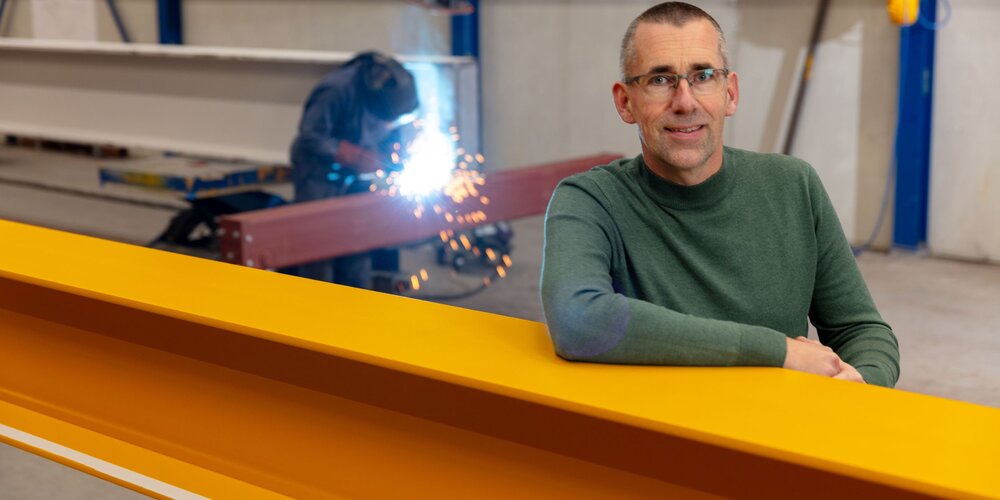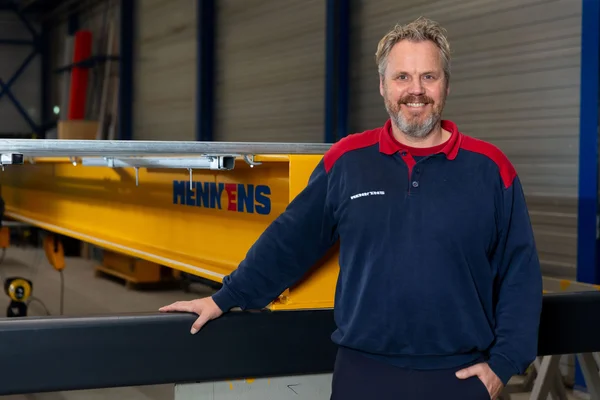
Our cranes: advanced and up to 40 meters long
Project manager Johan and inspector and service engineer Meindert on crane construction
Mennens has been building its own cranes since the 1990s. A lot has changed since then - organizationally and in the crane business itself. Project manager Johan Hoekstra and Meindert Wiersma, inspector and service engineer below and above the hook, have been there since day one. They talk about their experiences now and then.
Johan and Meindert have known one another for a long time and in the past have worked together a lot. Johan: "Nowadays I focus mainly on the regular crane projects and Meindert takes the special projects. Special projects involve more electrical engineering. Also, the lead time is longer: at least three months."
Special crane projects
Meindert gives an example of a special project: "Last winter we converted two cranes at a concrete plant. I made sure the cranes can communicate with one another by installing new radio controls. In addition to this kind of assembly work, I carry out tests and inspections, provide service in case of breakdowns and give advice on lifting issues."
Workshop expansion
Over the years, the demand for cranes grew so much that a larger workshop was needed. It doubled in size. And in fact it is already in need of expansion. Johan: "We used to be able to build cranes with a maximum length of 15 meters. Now it is 40 meters. That involves a lot of work. Like the transport. Most cranes are transported in their entirety by truck. To keep everything safe, there are also accompanying vehicles. Sometimes we transport at night."
Technological developments
Meindert: "The cranes are also becoming more complex. Technology is in full development. For example, our cranes are now equipped with frequency regulators as standard, which make the crane move more precisely and smoothly and therefore last longer. We also install a black box in every crane. This is a computer in the crane that registers the hoisting movements and brake circuits, among other things. The black box calculates, for example, when the lifting brake needs to be replaced or when the hoist needs a general revision."
Mapping the lifting requirement(s)
"Those measurements help me prepare the quotation. And that is very important," Johan says. "Everything depends on correctly mapping out the customer's lifting needs in combination with the dimensions of the hall. Building and installing a crane is precision work down to the millimetre. It is essential to listen carefully to the customer, keep asking and sometimes recommend something different to the original question."

Memorable projects
Mennens' cranes can be found in the most diverse places. From power plants to construction companies and from shipyards to theatres. Which project do Meindert and Johan remember most?
Johan: "For me, it was a customer in Friesland. They make natural stone kitchen countertops. They built a new hall of 65 by 140 meters where we installed seven overhead cranes, 20 column jib cranes and 400 meters of hoisting rail with various hoists. A large project. What made this extra special was the quick turnaround time. Usually, this kind of project involves up to one to two years of preparation. This time, everything - from quotation to completion - was arranged well within a year."
Meindert: "Last summer I replaced four hoists and the complete controls at a family business in Meppel. The father had recently passed away and the sons wanted to do a lot themselves. I showed them how and helped them. It went really well. After three days the crane was delivered fully operational. The personal contact made this project really special. The sons were very grateful and happy. That's what you do it for."
A Mennens crane in 10 steps
Installing a crane is always quite a process. Depending on its size, a project can take anywhere from a few months to up to two years, excluding the preliminary phase. It is important to pay attention to each step.
STEP 1: Assessing the application: 'coming up with the idea'
STEP 2: Comparing idea and budget
STEP 3: Making an offer
STEP 4: Preliminary analysis and ordering parts
STEP 5: Confirm to customer, check delivery times, finalize everything legally
STEP 6: Digitally draw the design and start construction in the workshop
STEP 7: Organize and provide transportation
STEP 8: Installation: lay the crane on the track, place power rail, install voltage, adjust limit switches
STEP 9: Test the crane with weight (125% of the working load) and adjust.
STEP 10: Finalizing: completing the crane book and handing everything over to the customer.
Mennens across the border
Meindert: "We now supply cranes all over the world, not just for the Netherlands anymore. We have a great team with lots of young, enthusiastic employees, as well as a number of veterans. That creates a nice dynamic in the group."





